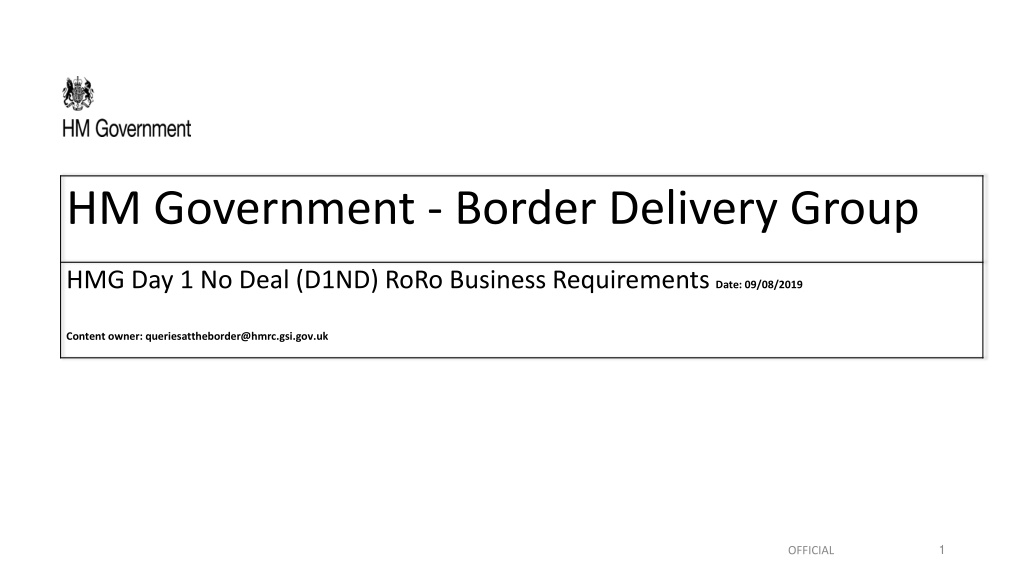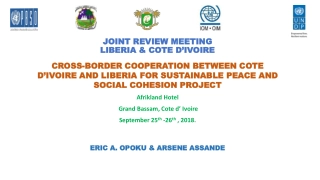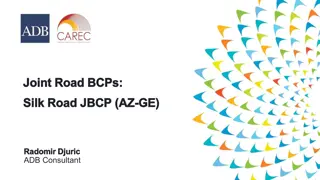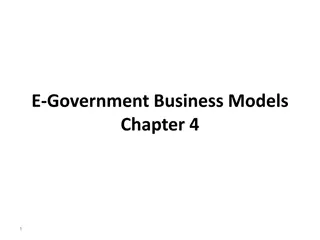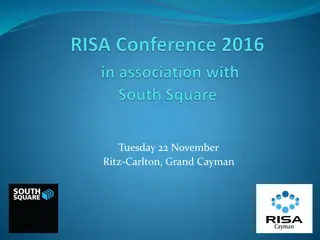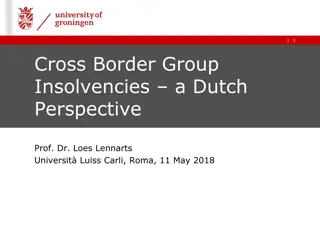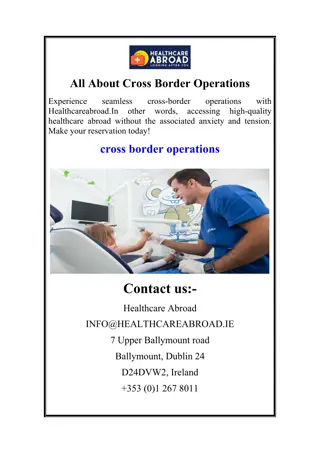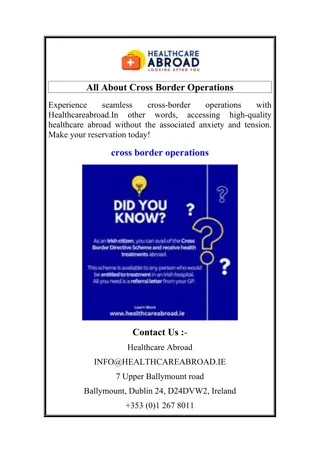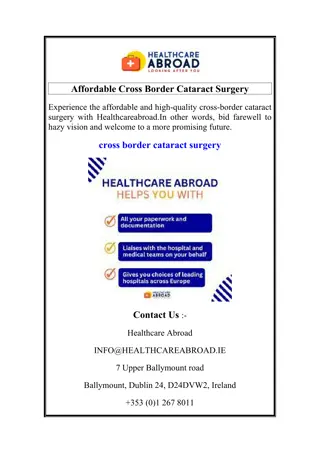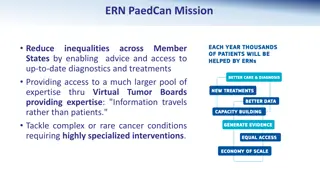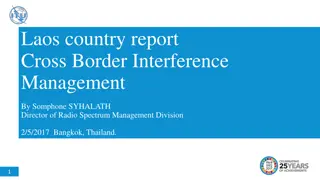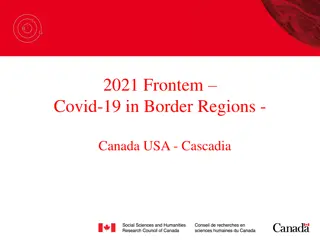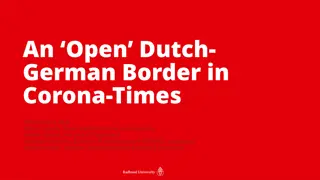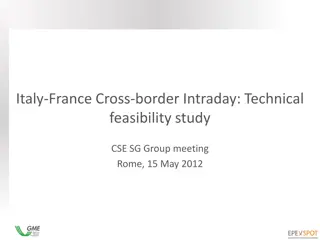HM Government Border Delivery Group - RoRo Business Requirements
The HM Government's Border Delivery Group outlines the Day 1 No Deal RoRo Business Requirements to prepare for potential scenarios post-Brexit. Businesses are encouraged to adhere to these guidelines to mitigate disruptions at the border. For detailed information, contact queriesattheborder@hmrc.gsi.gov.uk.
Download Presentation

Please find below an Image/Link to download the presentation.
The content on the website is provided AS IS for your information and personal use only. It may not be sold, licensed, or shared on other websites without obtaining consent from the author. Download presentation by click this link. If you encounter any issues during the download, it is possible that the publisher has removed the file from their server.
E N D
Presentation Transcript
HM Government - Border Delivery Group HMG Day 1 No Deal (D1ND) RoRo Business Requirements Date: 09/08/2019 Content owner: queriesattheborder@hmrc.gsi.gov.uk 1 OFFICIAL
Introduction We would prefer to leave the EU with a Deal, but the UK will be leaving the EU on the 31 October - whatever the circumstances. Detail on Brexit preparations are available at gov.uk/euexit In the event of no deal, we will prioritise security and flow. This approach will allow trade to flow freely whilst Government works towards its longer term objectives of balancing compliance with flow. The Roll-on Roll-off (RoRo) environment is key to UK-EU trade. Locations that support RoRo freight movements carry their own unique challenges including short crossing times, the onsite capacity required for physical intervention, and volume of freight flowing through the ports or tunnel. We will continue to work with business to help you meet compliance requirements, and there will be a number of easements in place for RoRo movements for the period following EU Exit, in order to give business more time to prepare for changes to EU-UK trade. Any additional checks in this environment will be undertaken off line, away from the flow of traffic. If this is possible within the port or tunnel environment, the checks may be done there. However, where this is not possible additional checks are to be undertaken elsewhere away from the border. The default position for RoRo is that all accompanied freight is free to board and disembark the ferries or the Le Shuttle trains as they do now, and only stop if they are required to by Border Force. Any checks that are performed currently by Border Force (or other agencies), in the port or terminal environment, will continue as they do now. 2 OFFICIAL
Purpose This detailed document sets out the key operational requirements of HMG Departments for the RoRo mode of transport, including: HM Revenue and Customs (HMRC) customs, excise and VAT Department for Environment, Food and Rural Affairs (DEFRA) / Animal and Plant Health Agency (APHA) / Food Standards Agency (FSA) Home Office (HO) / Border Force (BF) Department for Transport (DfT) licences, permits, insurance and cabotage Department for Business Energy and Industrial Strategy (BEIS) product standards and conformity This document recognises that technology driven solutions will not be in place for 31 October 2019 when the UK leaves the EU. Longer term, HMG will be engaging with business to develop these solutions. 3 OFFICIAL
Contents Slide No. Title 2 Introduction 3 5 - 6 7 - 12 13 14 15 16 46 49 50 Purpose Registration and pre-import processes RoRo Inbound Freight Passport controls Process map: RoRo non-juxtaposed border locations Process map: RoRo juxtaposed border locations (Calais/Dunkirk to Dover) Process map: RoRo juxtaposed border locations (Coquelles to Cheriton/Folkestone) RoRo Outbound freight Process map: RoRo non-juxtaposed border locations Process map: Roro juxtaposed border locations (Dover to Calais/Dunkirk) 51 Process map: juxtaposed border locations (Cheriton/Folkestone to Coquelles) 54 Annexes 55 Common Transit Convention (CTC) 63 ATA Carnets 69 79 Merchandise in Baggage Glossary & Terminology 4 OFFICIAL
Starting an import Starting an import Pre-import - registration & administrative processes these slides include: 1. What an Economic Operator Registration and Identification (EORI) number is and why it is needed 2. Pre-notification of certain goods e.g. agri-food, plants etc 3. Designation of UK border locations to import which categories of goods 4. Presentation and certification of which categories of goods 5. Role of a customs agent 6. Transitional simplified procedures for imports to the UK 7. Inbound interventions by UK Border Force OFFICIAL 5
Registration - Economic Operator Registration and Identification (EORI) number imports to the UK. WHO NEEDS AN EORI NUMBER AND WHY? Importers / their representatives To submit the relevant declaration to import goods using HMRC Systems CHIEF and CDS Haulier / Haulage Company / their representative Entry Summary Declarations (also known as Safety & Security Declarations) for imports coming into the UK will not be required for at least six months from 31st October 2019. Ferry Operator/ their representative To submit Entry Summary Declarations in ICS for unaccompanied imports. (will not be required for at least six months from 31 October 2019). An EORI number is needed to trade goods into (or out of) the UK and to apply to be authorised for customs simplifications. After the UK leaves the EU, UK businesses trading with the EU will need a UK EORI number to continue trading with the EU and make submissions via CHIEF and CDS. Traders who import goods to the UK and export goods from the EU will need both a UK EORI and an EU EORI number. However, if a UK trader is not directly interacting with EU customs authorities; for example if they are using a haulier or customs agent export goods from the EU, then that trader will not need an EU EORI. In this instance, they would only require a UK EORI to move the goods through UK customs. WHAT HAPPENS IF AN EORI NUMBER HAS NOT BEEN OBTAINED? Traders or their representatives will be unable to import (or export) goods. Haulage companies, ferry operators or their representatives will be unable to submit Entry Summary Declarations Can a EU EORI Number be used to submit Entry Summary Declarations in UK ICS. o No, a UK EORI Number is required to submit Entry Summary Declarations in UK s ICS. (Requirement for at least six months from 31st October 2019) Is a UK based business address required to obtain a UK EORI Number? o No, a RoW trader can apply for a UK EORI , even if the business is not UK established to do so. Does the Carrier / Trader need to register for a UK EORI number when using a representative / intermediary to submit declarations on their behalf? o No, either the trader / carrier or their authorised representative must have a valid EORI number. Can a business have both a EU and UK EORI Number? o Yes but only in a D1ND situation. To trade goods with the EU, registration for an EU EORI will be required for where the goods first enter the EU. WHERE TO FIND MORE INFORMATION? Current information relating to the EORI process, including how to register if you are VAT registered and if you are not, can be found here: https://www.gov.uk/eori https://www.gov.uk/guidance/get-a-uk-eori-number-to-trade-within-the-eu 6 OFFICIAL
Inbound freight - Agri-food / Products of animal origin (POAO), high-risk food not of animal origin (FNAO), live animals Requirements 1. EU high-risk food and feed, live animals, animal products, germplasm and animal by-products will be imported into the UK as they are now. Notifications will continue to be required for live animals and germplasm. Fish and fish products will require an accompanying catch certificate and will be subject to risk-based checks at ports. Risk-based checks for live animals, germplasm will take place at the final point of destination. 2. Live animals, products of animal origin (POAO), certain animal by-products and germplasm from non-EU countries will have to enter through a border inspection post for checks. 3. High risk food and feed not of animal origin from non-EU countries has to enter via a designated point of entry. 4. Live animals, germplasm and ABP that are subject to vet checks, from 3rd countries which travel through EU before arriving in UK, can enter the UK at any point of entry if they can demonstrate that vet checks have taken place at an EU BIP. 5. POAO and High Risk Food and Feed Not of Animal Origin (HRFNAO) will need to be notified on IPAFFS and checked at a UK BIP or designated points of entry (DPE). There is no BIP at Dover or Eurotunnel, there is no DPE at Eurotunnel. The DPE for the RoRo terminal at Dover is only approved for a restricted category of products. A list of DPEs is available at https://www.food.gov.uk/business- guidance/port-designations 6. Pre-notifications required from importers of high-risk food and feed products originating from the EU. Further guidance on how to pre-notify will be issued in due course. 7. Checks on international trade in endangered plant and animal species or products made from them. WHEN? On 1st point of entry from the EU into the UK for transit goods i.e. at the BIP/DPE From early 2020, for pre-notifications of high risk food and feed from the EU WHY DO THESE REQUIREMENTS NEED TO BE MET? 1. To maintain public health from risks originating from high-risk food and feed imports. 2. To allow DEFRA / FSA / APHA to undertake risk based controls on all high risk food and feed. 3. Imports of live animals, germplasm and ABPs may be checked at the premises of destination. 4. To ensure APHA and Port Health Authorities have sufficient guidance and facilities to conduct examinations on goods. 5. To prevent food fraud risk escalating and address sanitary and phytosanitary risks. WHAT HAPPENS IF THESE REQUIREMENTS ARE NOT MET? Non compliant products will be considered as illegal imports and will not be permitted to be placed on the UK market. Where detected, appropriate enforcement action will be taken. HOW SHOULD/COULD THESE REQUIREMENTS BE MET? 1. Accurate and timely pre-notification via IPAFFs for 3rd country trade and via APHA for live animals and germinal products 2. An initial process for pre-notifications of EU high-risk food and feed will be implemented by the FSA from early 2020. 3. Port Health Authorities will have sufficient capacity and food inspectors to meet extra demand from transit goods 4. Certain goods will need to be re-routed whilst within the EU so as to arrive in a UK BIP or DPE suitable for the type of commodities entering the UK. A list of all existing UK BIPs can be found here. A list of all existing UK DPEs can be found h WHERE TO FIND MORE INFORMATION - https://www.gov.uk/guidance/importing-animals-animal-products-and-high-risk-food-and-feed-not-of-animal-origin-if-the-UK-leaves-the-EU-with-no-deal https://www.gov.uk/food-safety-as-a-food-distributor - https://www.gov.uk/bringing-food-animals-plants-into-uk - https://www.gov.uk/government/publications/importing-high-risk-food-and-animal-feed- if-theres-no-brexit-deal--2 - a list of all existing UK BIPs can be found here: https://ec.europa.eu/food/sites/food/files/animals/docs/bips_contact_unitedkingdom.pdf - a list of all existing UK DPEs can be found here: https://www.food.gov.uk/business-guidance/port-designations A list of all existing UK DPEs can be found here 7 7 OFFICIAL
Import Requirement Importer or their appointed representative - pre-lodging an import Customs Declaration WHO WILL DO THIS AND WHEN? The Importer of the goods or their appointed representative must do this prior to the goods arriving at the point of departure. WHY DOES A VALID CUSTOMS DECLARATION NEED TO BE PRE-LODGED? It will be a legal requirement for Importers or their appointed representative to pre-lodge a customs declaration to enable the movement of goods from the EU into the UK if they are using a RoRo listed location. This should be done no earlier than 21 days prior to the goods arriving at the EU Port. WHAT HAPPENS IF A VALID CUSTOMS DECLARATION IS NOT PRE-LODGED? We expect customers to have made their declaration by the time of arriving at the port and being able to travel. We will support customers in understanding and complying with the requirements and will be proportionate and even-handed in our approach HOW SHOULD A CUSTOMS DECLARATION BE PRE-LODGED? There are three types of customs declarations which will allow the Importer to move goods into the UK: A full Customs Declaration - To be pre-lodged in HMRC System (CHIEF / CDS) A Simplified Frontier Declaration - To be pre-lodged in HMRC System (Transitional Simplified Procedures (TSP) registration or existing CFSP authorisation required) An Entry in the Declarants Records (EIDR) This is a simpler method as it does not require the information to be submitted into a HMRC system at the time of import. Instead the Customs Declaration is made within Trader s commercial records before the goods cross the border. The information that needs to be recorded in commercial records is detailed in the Transitional Simplified Procedure slide which follows this slide (TSP - Standard goods procedure registration or an existing CFSP authorisation is required). To make it easier to import goods from the EU through RoRo listed locations, declarations can be pre-lodged using an Entry in the Declarants Records (EIDR) or a Simplified Frontier Declaration (SFD), this allows the Importer to defer giving a full customs declaration and to defer paying any duty. To facilitate this, we will allow: Registration to the TSP scheme. This will permit traders to i) submit a SFD before crossing the border - TSP Controlled Goods Procedure, or ii) make an entry in their commercial records - TSP Standard Goods Procedure, to release goods to free circulation. Both of these would be followed up with a supplementary declaration by the 4th working day of the following month with payment. If using TSP standard goods procedure you may opt to delay submission of the supplementary declaration for 6 months from 31 October, it would be due by the 4th working day of May 2020 (which is 7 May). Intermediaries to submit Simplified Frontier Declarations or supplementary declarations on behalf of traders using the trader s TSP registration under the rules of direct representation (where the liability is with the trader). Intermediaries are not permitted to register for TSP, so are unable to act as indirect representatives for TSP. This does not affect existing CFSP processes. The trader must have a duty deferment account if any duties or VAT are payable, and will need to provide a financial guarantee to cover monthly liabilities by 30 April 2020. Please note that if a pre-lodged declaration hasn t been submitted, including the excise guarantee information provided for goods being imported for excise duty suspension arrangements, then the goods are liable to forfeiture. SHARE MRN, ENTRY NUMBER OR EORI NUMBER WITH HAULAGE COMPANY / DRIVER The electronic pre-lodgement of a Simplified Frontier Declaration (SFD) or Full Customs Declaration creates a CDS Movement Reference Number (MRN) or CHIEF Entry Number which is required by the driver should they be asked by Border Force to provide proof of customs formalities. Where a trader makes an Entry in Declarants Record (EIDR), the Trader sEORI Number which is required by the driver should they be asked by Border Force to provide proof of customs formalities. INCLUDE VEHICLE / TRACTOR OR TRAILER / CONTAINER REFERENCE ONTO CUSTOMS DECLARATION A new data item for RoRo will be required on the declaration, this is a vehicle registration number or trailer/container number. This should be entered onto the customs declaration if known at the point of pre- lodgement. If it is not known at this point, the trader / their representative can enter unknown . Details must be entered before the status of declaration is updated to show goods have arrived. WHERE TO FIND MORE INFORMATION https://www.gov.uk/guidance/moving-goods-to-and-from-the-eu-through-roll-on-roll-off-locations-including-eurotunnel https://www.gov.uk/guidance/import-declaration-completion-guide https://www.gov.uk/government/collections/chief-user-guides-and-technical-specifications OFFICIAL 8
Import (customs) easements - Transitional Simplified Procedures (TSP) HMRC has put in place transitional simplified procedures to make it easier to import goods from the EU through roll on roll off locations. TSP will give access to the Simplified Frontier Declaration and Entry in Declarants Records Using TSP will reduce the amount of information you need to give in an import declaration when the goods are crossing the border. This will allow you to defer giving a full declaration and paying duties. Type of Goods Can a Full Customs Declaration be used? Can TSP Simplified Frontier Declaration be used? Can TSP EIDR be used? TSP Controlled Goods Yes Yes No All other goods Yes Yes Yes Under transitional simplified procedures, there are two ways of declaring, depending on the types of goods you are importing. CONTROLLED GOODS PROCEDURE If the importer / declarant uses transitional simplified procedures they must follow the controlled goods process if importing goods listed in the TSP Controlled goods list (Link to guidance and full list of goods can be found below): Electronically submit a Simplified Frontier Declaration before you import the controlled goods into the UK into HMRC systems CHIEF / CDS Make sure that the correct licences and/or certificates for controlled goods have been obtained, declared and are available for inspection. Share the MRN or Entry Number with the Haulage Company / Driver, should they be asked to provide proof of customs formalities being completed by Border Force during their journey. Send a supplementary declaration by the fourth working day of the month following the arrival of the goods into the UK HMRC will take your direct debit in the month that the supplementary declaration is submitted, if you have duties or taxes to pay and have not imported goods under excise duty suspension arrangements. STANDARD GOODS PROCEDURE If you re importing goods that are not on the transitional simplified procedures controlled goods list you ll need to make a Customs declaration within your commercial records before the goods cross the border (also known as Entry in Declarants Record EIDR). This is a simpler method as it does not require the information to be submitted into a HMRC system. What information do I need to include within my commercial records? a unique reference number for each consignment a description of the goods and the commodity code and quantity imported purchase and (if available) sales invoice numbers the customs value delivery details supplier emails serial numbers of any certificates or licences After you've imported the goods, you'll need to update your commercial records with the date and approximate time the goods arrived in the UK. You'll also need to send a supplementary declaration by the fourth working day of the month following the arrival of the goods into the UK. When using TSP standard goods procedure you may opt to delay submission of the supplementary declaration for 6 months from 31 October, it would be due by the 4th working day of May 2020 (which is 7 May). HMRC will take your direct debit in the month that the supplementary declaration is submitted, if you have duties or taxes to pay. WHERE TO FIND MORE INFORMATION? Guidance on Transitional Simplified Procedures : https://www.gov.uk/guidance/register-for-simplified-import-procedures-if-the-uk-leaves-the-eu-without-a-deal The full list of controlled goods for Transitional Simplified Procedures : https://www.gov.uk/guidance/list-of-controlled-goods-for-transitional-simplified-procedures 9 OFFICIAL
Inbound freight controls over Plants and Plant Health Requirements 1. For regulated plants/plant products from EU - Importers will pre-notify APHA (in England and Wales, or the relevant Devolved Administration) of the arrival of the regulated consignment using the PEACH system but the goods will not be held at the border 2. For regulated plants/plant products from EU - Remote documentary and identity checks carried out by plant health inspectors after the border. For non-regulated plants/plant products from the EU (fruit, veg, cut flowers) there will be no plant health controls 3. Consignments transiting from third countries, through the EU, to the UK; EU will no longer be required to carry out checks at first point of entry, although if a consignment is entered for customs clearance, EU plant health checks will take place and commodity will become an EU good for biosecurity purposes 3rd country goods arriving at RoRo ports will move inland for checks at authorised trade premises Amendments to plant health IT systems to auto-clear goods through customs systems at RoRo ports, ensuring that consignments are not held at the border 4. Wood packaging material including pallets and crates must be ISPM15 compliant (treated and marked). WHEN? EU plants and plant products will continue to flow across the border without stopping for physical plant health checks. Checks on consignments transiting through EU from third countries and entering at RoRo ports, will take place at trade premises. Alternatively, the trader will select to enter at a non-RoRo DPE where plant health checks will take place at the border as they do currently WHY DO THESE REQUIREMENTS NEED TO BE MET? 1. To fulfil statutory UK requirements and address phytosanitary risk. 2. To allow plants to enter UK with appropriate controls. WHAT HAPPENS IF THESE REQUIREMENTS ARE NOT MET? If no SPS certificate at the EU departure port, the consignments may be held/delayed/returned if statutory UK requirements are not met. HOW SHOULD/COULD THESE REQUIREMENTS BE MET? 1. Timely application for phytosanitary certificates in the exporting member state 2. Timely pre-notification to APHA WHERE TO FIND MORE INFORMATION Plant Technical Notice - https://www.gov.uk/guidance/importing-and-exporting-plants-and-plant-products-if-theres-no-withdrawal-deal Further information - https://www.gov.uk/government/publications/plant-species-by-import-category - https://www.gov.uk/government/publications/plant-imports-additional-declarations- for-phytosanitary-certificates 10 OFFICIAL
Inbound Requirements for Endangered species regulated under CITES (Convention for International Trade in Endangered Species) Requirements 1. Species that are listed under the CITES regulations and are being imported into the UK from the EU will require a CITES import permit or import notification, and may require an export permit, re-export certificate or certificate of origin. The exact process will depend on the annex which the species is listed in. Annex A and B: imports to the UK from the EU would need an export permit (or re-export certificate) from the EU country of export, and an import permit from APHA. Annex C: imports to the UK from the EU would need an export permit, re-export certificate or certificate of origin from the EU country of export and an import notification on entry to the UK. Annex D: imports to the UK from the EU would need an import notification on entry to the UK. 2. The export permit (or re-export certificate) is wet stamped by a customs officer upon exit from the EU, and both the export and import permit/notification is wet stamped by a customs officer upon entry into the UK. 3. CITES specimens can only enter and leave the UK at designated CITES points of entry. For further information see https://www.gov.uk/guidance/trading-cites-listed-species-through-uk- ports-and-airports-after-brexit . 4. Dependent on the type of CITES specimen, further/additional requirements may be in place e.g. export health certificates for live animals etc. Please review the relevant section of this pack. WHEN? At point of exit from the EU and at first point of entry into the UK. WHY DO THESE REQUIREMENTS NEED TO BE MET? 1. To fulfil our international obligations under CITES WHAT HAPPENS IF THESE REQUIREMENTS ARE NOT MET? If no valid CITES import permit and necessary export permit or certificate is presented at the UK point of entry, the goods will not be allowed to proceed and may be seized because it is an import requirement. HOW SHOULD/COULD THESE REQUIREMENTS BE MET? 1. Timely application for CITES permit or import/export notification 2. Use designated CITES ports of entry and exit between the UK and the EU. See https://www.gov.uk/guidance/trading-cites-listed-species-through-uk-ports-and-airports-after-brexit WHERE TO FIND MORE INFORMATION CITES Technical Notice - https://www.gov.uk/guidance/trading-and-moving-endangered-species-protected-by-cites-if-theres-no-withdrawal-deal UK CITES Points of Entry (in a no deal scenario) https://www.gov.uk/guidance/trading-cites-listed-species-through-uk-ports-and-airports-after-brexit EU CITES Points of Entry (current situation) - http://ec.europa.eu/environment/cites/pdf/list_points_of_entry.pdf 11 OFFICIAL 11
Inbound freight - Home Office - Border Force Requirements 1. Facilities sufficient and appropriate to allow Border Force to conduct its immigration and customs controls, checks and examinations at points at entry to and exit from to the UK 2. Manage the border approval and authorisation processes as required by law including CEMA 1979 3. Consignment data to allow risk targeting WHY DO THESE REQUIREMENTS NEED TO BE MET? Border Force are underpinned by law, as the agency operating for wider government at the border and required to : Secure the border Protect UK from terrorism and other threats to UK security Enforce prohibitions and restrictions and fiscal irregularities through the seizure of for example, drugs, cash, tobacco products including cigarettes Recognise the importance of trade flow for the UK s prosperity WHAT HAPPENS IF THESE REQUIREMENTS ARE NOT MET? Border Force is committed to managing control processes in a way which will minimise delays or issues for the flow of trucks through RoRo ports. Safety & Security: Any vehicle and consignment may be subject to checks at the border, as they currently are for security purposes, under an intelligence-led, risk-based approach. Such checks will continue. Border Force will not be systematically stopping vehicles as they disembark to ensure they have completed the correct customs declaration. No need to stop unless pulled out of the flow by Border Force at its selection points. As far as is possible regulatory and fiscal checks will be conducted at locations away from the port. WHERE TO FIND MORE INFORMATION https://www.gov.uk/uk-border-control - https://www.gov.uk/airport-rights 12 OFFICIAL
UK Border Force: Passport Controls Ensuring a frictionless border from day one will be a priority. EU nationals will continue to be able to enter the UK as now, using e-Passport gates when travelling on a biometric passport. EU nationals will also be able to enter the UK for short-term visits without a visa. Until 31 December 2020, EU citizens will be able to enter the UK by showing their valid national identity card for up to three months during which time they will be permitted to work, study or simply visit. In the event of no deal, and once free movement has ended, EU citizens who wish to stay longer than three months will need to apply to the Home Office for leave to remain within three months of arrival. EU nationals currently resident in the UK should register now for EU Settled Status to confirm their right of residence beyond 31st October. Those with 5 or more years residence will be granted permanent status immediately. Those with less than 5 years will be granted pre-settled status which can be converted to settled status once 5 years residence is completed. OFFICIAL 13
RoRo Inbound freight process maps The user journeys illustrated on the following 3 slides represent a high level description of how the D1ND inbound freight processes will flow. Slide 15 : RoRo freight through non-juxtaposed border locations Slide 16 : RoRo freight through juxtaposed border locations - Calais/Dunkirk to Dover Slide 17 : Channel Tunnel freight through juxtaposed border locations - Coquelles to Cheriton/Folkestone The subsequent pages outline in more detail how the process can be operated for Day 1 and beyond. The Day 1 RoRo process is designed to enable goods to clear RoRo locations without disrupting flow. HMG does not require RoRo listed locations to provide additional temporary storage for Day 1, although the private sector may have commercial reasons for increasing their own temporary storage facilities. The volume of Border Force checks at RoRo locations will not materially change. Where Border Force stop a vehicle they will also seek evidence that customs processes have been complied with. Entry Summary Declarations (also known as Safety & Security Declarations) for imports coming into the UK will not be required for at least six months from 31st October 2019 14 OFFICIAL
HMG vfinal Day 1 No Deal - RoRo Imports to the UK During crossing At EU port check-in point Pre-departure At UK Port IMPORTER/ APPOINTED REPRESENTATIVE 3. If the goods require a licence, apply to the issuing HMG Dept at least 2 weeks in advance of shipping. High-risk food and feed products entering the UK must be pre- notified. For high- risk food not of animal origin (FNAO), this must be at least one day prior to arrival. 16. For full declarations; Import, Excise duties and Import VAT will be calculated and become due upon notification of goods arrival and entry acceptance. The importer or their representative can defer payment. For CFSP & Transitional Simplified Procedures the importer will be able to defer Import duties, excise duties and Import VAT payable. To defer payment of duties or taxes you will need a duty deferment account. Alternatively, the imported goods can be customs cleared to customs or excise duty suspension arrangements. For excise goods, the movement must be raised by a Registered Consignor via the Excise Movement & Control System for storage in an authorised excise warehouse. 5. Electronically complete either a full customs declaration, or, for a temporary period under Transitional Simplified Procedures (TSP) complete; For standard goods an entry in declarant s records (EIDR) For controlled and excise goods a simplified declaration into HMRC System CHIEF / CDS. If you already hold an authorisation for your ROW trade, you can use this to make simplified declarations / EIDR for your EU trade. Include tractor or trailer/container reference onto customs declaration if known. 12. Importer/Appointed representative updates status of customs declaration to show goods have arrived in the UK. A Full or Simplified Customs Declaration must be arrived by the end of the working day following the physical crossing. 1. All traders register for an EORI number 2. If you don t already have an agent or hold a customs authorisation,you can registerfor TSP and if neededget an agent or software to help you make declarations If the vehicle/tractor or trailer/container was not initially included on the customs declaration, add this information in before the declaration is arrived. EIDR The arrival will be deemed at the point the border is crossed, and does not require confirmation 6. Provides MRN(s) / Entry no. / EORI no. (of importer) to Haulage Company. Supplementary Customs Declaration submitted by 4th working day of following month for Simplified Frontier Declaration and EIDR If using TSP standard goods procedure you may opt to delay submission of the supplementary declaration until 4th working day of May 2020 9. Checks in for boarding at EU Port. Accompanied Driver moves goods to vessel. Unaccompanied Driver takes trailer where instructed by EU Port Operator. / HAULAGE COMPANY 7. Driver collects goods and MRN EORI number/ Entry Number 20. Continues Onward Journey (goods to be taken to an inland customs facility as necessary) 8. Haulage Company submits Entry Summary Declaration (Accompanied) Requirement from 30 April 2020 17. Present MRN / Entry No. / EORI number if requested by Border Force to provide proof of custom formalities. Haulage company confirms to importer goods have checked in 14. Accompanied and Unaccompanied freight unloads from vessel FERRY OPERATOR 10. Submits Entry Summary Declaration (Unaccompanied only) Requirement from 30 April 2020 11. Has reasonable belief appropriate declarations have been made PORT OPERATOR Importer may be contacted for more information. If documentary checks are required, the declaration and documents must be submitted to NCH@hmrc.gov.uk as soon as possible KEY HMG 13. HMRC and wider OGDs undertake checks (where appropriate) Expected Path 19. BF and/or OGDs take action as appropriate (as pre-March 2020). 15. BF undertake checks on selected vehicles and requests proof of customs formalities 18. BF checks the MRN(s) / Entry Number / EORI Number. 4. Licence issued Additional steps (if required) 15 OFFICIAL
HMG vfinal Day 1 No Deal - Inbound freight Imports to the UK through the RoRo juxtaposed border locations - Calais/Dunkirk - Dover At Dover During crossing At Calais / Dunkirk Pre-departure IMPORTER/ APPOINTED REPRESENTATIVE 13. Importer/Appointed representative updates status of customs declaration to show goods have arrived in the UK. A Full or Simplified Customs Declaration must be arrived by the end of the working day following the physical crossing. 15. For full declarations; Import, Excise duties and Import VAT will be calculated and become due upon notification of goods arrival and entry acceptance. For CFSP & Transitional Simplified Procedures the importer will be able to defer Import duties, excise duties and Import VAT payable. To defer payment of duties or taxes you will need a duty deferment account. Alternatively, the imported goods can be customs cleared to customs or excise duty suspension arrangements. For excise goods, the movement must be raised by a Registered Consignor via the Excise Movement & Control System for storage in an authorised excise warehouse. 3. If the goods require a licence, you need to apply to the issuing HMG Dept at least 2 weeks in advance of shipping. High-risk food and feed products destined for the UK must be pre-notified. For high-risk food not of animal origin (FNAO), this must be at least one day prior to arrival. 5. Electronically complete either a full customs declaration, or, for a temporary period under Transitional Simplified Procedures (TSP) complete; For standard goods an entry in declarant s records (EIDR) For controlled and excise goods a simplified declaration into HMRC System CHIEF / CDS. If you already hold an authorisation for your ROW trade, you can use this to make simplified declarations / EIDR for your EU trade. Include tractor or trailer/container reference onto customs declaration if known. 1. All traders register for an EORI number 2. If you don t already have an agent or hold a customs authorisation,you can registerfor TSP and if needed get an agent or software to help you make declarations If the vehicle/tractor or trailer/container was not initially included on the customs declaration, add this information in before the declaration is arrived. EIDR The arrival will be deemed at the point the border is crossed, and does not require confirmation 6. Provides MRN(s) / Entry no. / EORI No. (of importer) to Haulage Company. Supplementary Customs Declaration submitted by 4th working day of following month for Simplified Frontier Declaration and EIDR. If using TSP standard goods procedure you may opt to delay submission of the 4th working day of May 2020 9. Checks in for boarding at EU Port. Accompanied Driver moves goods to vessel. Unaccompanied Driver takes trailer where instructed by EU Port Operator. 7. Driver collects goods and MRN / Entry Number / EORI Number HAULAGE COMPANY 21.Continues Onward Journey (goods to be taken to an inland customs facility as necessary) 18. Present MRN / Entry No. / EORI number if requested by Border Force to provide proof of custom formalities. 8. Haulage company submits Entry Summary Declaration (Accompanied) Requirement from 30 April 2020 Haulage company confirms to importer goods have checked in 16. Accompanied and Unaccompanied freight unloads from vessel Importer may be contacted for more information. If documentary checks are required, the declaration and documents must be submitted to NCH@hmrc.gov.uk as soon as possible FERRY OPERATOR 11. Has reasonable belief appropriate declarations have been made 10. Submits Entry Summary Declaration (Unaccompanied only) Requirement from 30 April 2020 KEY HMG 12. Border Force conduct immigration controls including 100% passport checks and search selected vehicles for clandestines 17. BF undertake checks on selected vehicles and requests proof of customs formalities 14. HMRC and wider OGDs undertake checks (where appropriate). Expected Path 19. BF checks the MRN(s) / Entry Number / EORI Number 20. BF and/or OGDs take action as appropriate. 4. Licence issued Additional steps (if required) OFFICIAL 16
HMG vfinal Day 1 No Deal - Inbound freight - Imports to the UK through juxtaposed controls Coquelles to Folkestone During Channel Journey At Eurotunnel EU Terminal Pre-departure At Eurotunnel UK Terminal IMPORTER/ APPOINTED REPRESENTATIVE 15. Importer/Appointed representative updates status of customs declaration to show goods have arrived in the UK. 1. All traders register for an EORI number 5. Electronically complete either a full customs declaration, or, for a temporary period under Transitional Simplified Procedures (TSP) complete; For standard goods an entry in declarant s records (EIDR) For controlled goods a simplified declaration into HMRC System CHIEF / CDS. If you already hold an authorisation for your ROW trade, you can use this to make simplified declarations / EIDR for your EU trade. Include vehicle/tractor or trailer/container reference onto customs declaration if known. 18. For full declarations; Import, Excise duties and Import VAT will be calculated and become due upon notification of goods arrival and entry acceptance. For CFSP & Transitional Simplified Procedures the importer will be able to defer Import duties, excise duties and Import VAT payable. To defer payment of duties or taxes you will need a duty deferment account. Alternatively, the imported goods can be customs cleared to customs or excise duty suspension arrangements. For excise goods, the movement must be raised by a Registered Consignor via the Excise Movement & Control System for storage in an authorised excise warehouse. A Full or Simplified Customs Declaration must be arrived by the end of the working day following the physical crossing. 2. If you don t already have an agent or holda customs authorisation, you can register for TSP and if neededget an agent or software to help you make declarations 3. If the goods require a licence, you need to apply to the issuing HMG Dept at least 2 weeks in advance of shipping. If the vehicle/tractor or trailer/container was not initially included on the customs declaration, add this information in before the declaration is arrived. EIDR The arrival will be deemed at the point the border is crossed, and does not require confirmation. 6. Provides MRN(s)/ Entry Number EORI Number (of importer) to Haulage Company. 9. Checks in for boarding at EU Terminal. Driver moves goods onto train as directed. Haulage company confirms to importer goods have checked in. Supplementary Customs Declaration submitted by 4th working day of following month for Simplified Frontier Declaration and EIDR. If using TSP standard goods procedure you may opt to delay submission of the supplementary declaration until 4th working day of May 2020. HAULAGE COMPANY 14. Present MRN / Entry No. / EORI number if requested by Border Force to provide proof of custom formalities. 7. Driver collects goods and MRN / Entry Number / EORI Number 8. Haulage company submits Entry Summary Declaration Requirement from 30 April 2020 19. Continues Onward Journey (goods to be taken to an inland customs facility as necessary) 17. Freight disembarks from train. EUROTUNNEL OPERATOR 10. Has reasonable belief appropriate declarations have been made Importer may be contacted for more information. If documentary checks are required, the declaration and documents must be submitted to NCH@hmrc.gov.uk as soon as possible KEY 11. BF undertake checks on selected vehicles HMG 16. HMRC and wider OGDs undertake checks (where appropriate). Expected Path 4. Licence issued 12. BF checks the MRN(s) / Entry Number / EORI Number Additional steps (if required) OFFICIAL 13. BF and/or OGDs take action as appropriate. 17
Haulier & RoRo operator / carrier requirements goods for import to the UK OFFICIAL 18
What a Haulier should expect on Day 1 - inbound to RoRo locations in the UK All inbound vehicles will continue to pass through UK RORO terminals, from the disembarkation ramp to the dock/terminal exit, as freely as they do now, with: No need to demonstrate at the terminal that a customs declaration has been made, or that any other documentation relating to goods (such as a health certificate) is in order; No need to demonstrate at the terminal that a haulier has the necessary permit (if one is needed) to use UK roads or that the driver has a valid licence; No need to stop unless pulled out of the flow (or offloaded) by Border Force or the Port Health Authority at its selection points. If pulled, evidence will need to be provided to demonstrate that appropriate customs declarations have been made. No change to the manner of Border Force operations at its selection points, with vehicles continuing to be directed out of the traffic flow into examination areas by non-verbal means; OFFICIAL 19
Drivers hours and Certificate of Professional Competence Drivers hours The UK s Department for Transport will respond rapidly to urgent situations by temporarily relaxing the drivers hours rules where it is in the public interest to do so. The details, including the scope of the relaxation, are determined on a case-by-case basis following close engagement with affected industry sectors. In the past this facility has been made use of during roads disruption caused by events such as adverse weather conditions and disruption on the road networks to cross-Channel traffic. Driver Certificate of Professional Competence (CPC) The EU has indicated that UK-issued CPC will not be recognised for employment in the EU. Holders of a UK Driver CPC who are currently working for an EU company may want to exchange their UK CPC for an EU CPC before 31/10/2019. Exchanging CPC in this way will have no effect on a driver s ability to work in the UK because the UK will continue to recognise EU-issued CPC. OFFICIAL 20
Other transport documentation requirements Transport documentation for EU hauliers will remain the same, with no new documents or processes. The UK Government has confirmed it will: Continue with existing driver hour arrangements Recognise driver and transport manager Certificate of Professional Competence (CPC) Recognise EU issued driving licences Recognise EU Community licence you will not need an ECMT permit to access the UK Insurance In the event of a no deal, a Green Card or other proof of Insurance will be required, as set out in UK legislation. If a driver has different policies for their trailer and vehicle they will be required to bring proof of insurance for each. Cabotage As the EU Regulation on maintaining basic connectivity has now been approved, the laws are in place to reciprocate the current rights for EU hauliers and bus operators after exit day, including on cabotage and cross-trade OFFICIAL 21
Import Requirement Haulier must carry evidence that a customs declaration has been pre-lodged / made WHO WILL DO THIS AND WHEN? WHY DOES THE DRIVER NEED TO CARRY PROOF THAT A CUSTOMS DECLARATION HAS BEEN MADE? The driver of the vehicle moving the goods will need the trader / their representative to share evidence that a customs declaration has been made for the goods being carried. The driver may be stopped by Border Force and asked to provide evidence of customs formalities. WHAT HAPPENS IF THE DRIVER IS ASKED TO PROVIDE EVIDENCE OF CUSTOMS FORMALITIES BY BORDER FORCE BUT IS UNABLE TO DO SO? We expect customers to have made their declaration and shared the appropriate evidence with the Haulage Company before the goods are imported into the UK. We will support customers in understanding and complying with the requirements and will be proportionate and even-handed in our approach. WHAT SHOULD THE DRIVER CARRY AS EVIDENCE THAT A CUSTOMS DECLARATION HAS BEEN SUBMITTED? The trader / their representative will share the Movement Reference Number (MRN), Entry Number or EORI number with the Haulage Company or Driver as proof that a customs declaration has been made. The driver will need to carry evidence that customs formalities have been met for all goods being imported. This will mean a MRN, Entry number or EORI Number for each customs declaration submitted (or EIDR) including evidence such a alphanumeric format receipts for the goods being carried. The electronic pre-lodgement of a Simplified Frontier Declaration (SFD) or Full Customs Declaration creates a CDS Movement Reference Number (MRN) or CHIEF Entry Number which is required by the driver should they be asked by Border Force to provide proof of customs formalities. Where a trader / their representative makes an Entry in Declarants Record (EIDR), the Trader sEORI Number is required to be presented by the driver should they be asked by Border Force to provide proof of customs formalities. WHERE TO FIND MORE INFORMATION https://www.gov.uk/guidance/moving-goods-to-and-from-the-eu-through-roll-on-roll-off-locations-including-eurotunnel 22 OFFICIAL
Import Requirement Safety & Security declarations - Haulage company or Ferry Operator submits an Entry Summary Declaration Entry Summary Declarations (also known as Safety & Security Declarations) for imports coming into the UK will not be required until 30 April 2020 WHY DOES AN ENTRY SUMMARY DECLARATION NEED TO BE SUBMITTED? If the UK has left the European Union it must continue to secure its borders effectively in keeping the country safe. It will be a legal requirement to submit an Entry Summary Declaration after 30 April 2020. WHO WILL DO THIS AND WHEN? Entry Summary Declarations (also known as Safety & Security Declarations) for imports coming into the UK will be a legal requirement after 30 April 2020. This legal obligation lies with the: Ferry Operator if goods are Unaccompanied Haulage company if goods are Accompanied This must be lodged at least two hours before the goods are due to arrive in the UK, (for Channel Tunnel, due to Juxtaposed controls this must be lodged at least one hour before arrival at the Eurotunnel EU terminal), by the Ferry Operator if goods are Unaccompanied Haulage company if goods are Accompanied WHAT HAPPENS IF AN ENTRY SUMMARY DECLARATION IS NOT SUBMITTED? We expect carriers or their representatives to have made their declaration by the time of arriving at the port and being able to travel. We will support carriers or their representatives in understanding and complying with the requirements and will be proportionate and even-handed in our approach. HOW SHOULD AN ENTRY SUMMARY DECLARATION BE SUBMITTED? For Accompanied goods, the Haulage Company must submit an Entry Summary Declaration For Unaccompanied goods, the Ferry Operator must submit an Entry Summary Declaration For Unaccompanied goods, as the declaration must be lodged two hours before arrival in the UK, the Ferry Operator may meet this requirement by: Ensuring there is sufficient time before permitting travel to allow the declaration to be made (i.e. providing a two hour gap before arrival in the UK) Delegating this activity to the Importer/their agent or the Haulage company. The Ferry Operator remains liable if the declaration has not been completed. The haulier or ferry operator can pass the responsibility to submit Entry Summary declarations to a third party, for example, by using Terms and Conditions. If responsibility is passed on to a third party the legal liability to ensure that a Entry Summary declaration is submitted remains with the haulier or ferry operator. However, the responsibility that the information provided is accurate and correct lies with whoever the declarant is, in this case, the third party. HMRC does not require the haulier or ferry operator to keep evidence that a Entry Summary declaration has been submitted, this applies whether the haulier / ferry operator submits the declaration themselves or a third party submits on their behalf. WHERE TO FIND MORE INFORMATION https://www.gov.uk/government/news/hmrc-outlines-phased-approach-for-entry-summary-declarations 23 OFFICIAL
Import Requirement Ferry Operator / Eurotunnel confirms with Haulage company or driver that the relevant declarations have been made WHO WILL DO THIS AND WHEN? WHY DOES A FERRY OPERATOR / EUROTUNNEL NEED TO CHECK CUSTOMS DECLARATIONS ARE IN PLACE? Prior to allowing the vehicle to board the ferry / train, the Ferry Operator / Eurotunnel must have a reasonable belief that the goods carried by the driver have associated pre-lodged customs declarations And The Ferry Operator must complete an Entry Summary Declaration if the goods are Unaccompanied. Entry Summary Declarations for imports coming into the UK will be required after 30 April 2020. It will be a legal requirement for the Ferry Operator / Eurotunnel to have a reasonable belief that a customs declaration has been pre-lodged And It will be a legal requirement for the Ferry Operator to complete an Entry Summary Declaration if the goods are unaccompanied. The requirement for Entry Summary Declarations for imports coming into the UK will be phased in over 6 months following EU Exit. WHAT HAPPENS IF EUROTUNNEL OR A FERRY COMPANY ARE ADVISED THAT THE RELEVANT DECLARATIONS ARE NOT IN PLACE? All customers must declare that these have been completed before being allowed to complete the check-in and boarding process. The Ferry Operator / Eurotunnel can obtain reasonable belief that these have been completed through use of terms and conditions of booking. HOW CAN THE FERRY OPERATOR / EUROTUNNEL CHECK A CUSTOMS DECLARATION HAS BEEN PRE-LODGED? The Ferry operator / Eurotunnel will be required to have reasonable belief that goods being transported on their vessel / train have Customs declarations in place before the vehicle carrying them boards the vessel / train. The ferry operator / Eurotunnel could satisfy this requirement by putting this in their terms and conditions. HOW DOES THE FERRY OPERATOR / EUROTUNNEL PROVIDE THE REQUIRED EVIDENCE TO HMRC? A copy of the completed terms and conditions of booking can be used as evidence at the request of HMRC that reasonable belief has been secured. WHERE TO FIND MORE INFORMATION https://www.gov.uk/guidance/moving-goods-to-and-from-the-eu-through-roll-on-roll-off-locations-including-eurotunnel 24 OFFICIAL
Inbound freight fluidity through the RoRo locations on disembarkation All inbound vehicles will continue to pass through UK RORO terminals, from the disembarkation ramp to the dock/terminal exit, as freely as they do now, with: No need to demonstrate at the terminal that a customs declaration has been made, or that any other documentation relating to goods (such as a health certificate) is in order; No need to demonstrate at the terminal that a haulier has the necessary permit (if one is needed) to use UK roads or that the driver has a valid licence; No need to stop unless pulled out of the flow (or offloaded) by Border Force or the Port Health Authority at its selection points; No change to the manner of Border Force operations at its selection points, with vehicles continuing to be directed out of the traffic flow into examination areas by non-verbal means; WHEN? WHY DO THESE REQUIREMENTS NEED TO BE MET? Not applicable. Not applicable. WHAT HAPPENS IF THESE REQUIREMENTS ARE NOT MET? Not applicable. HOW SHOULD/COULD THESE REQUIREMENTS BE MET WHERE TO FIND MORE INFORMATION www.gov.uk (partnership pack) 25 OFFICIAL
Ending an import - UK importer requirements OFFICIAL 26
Import Requirement Importer or their appointed representative confirms goods have arrived and are available for customs presentation WHO WILL DO THIS AND WHEN? WHY IS CONFIRMATION OF THE ARRIVAL OF GOODS REQUIRED? The Importer or their appointed representative must update the status of the customs declaration to confirm the goods have arrived. This needs to be done by midnight of the next working day following crossing, although we recommend this is done as soon as possible. It is a requirement for the Importer or their appointed representative to provide an arrival notification showing the goods have now been imported into UK. This enables HMRC to have the information that the goods have arrived and it can update its data systems accordingly. Traders using EIDR are exempt from this step as arrival will be deemed when goods cross the frontier. WHAT HAPPENS IF GOODS ARE NOT ARRIVED? The goods will not have been legally presented to customs and will not be cleared. HOW SHOULD THE GOODS BE ARRIVED? A Full or Simplified Customs Declaration must be arrived by midnight of the next working day following the physical crossing. The Haulage Company must communicate with the Importer or their appointed representative to confirm that the goods have arrived in the UK. This enables the Importer or their appointed representative to update the status of the pre-lodged customs declaration in HMRC systems to confirm the goods have arrived, this must be done by midnight of the next working day following crossing, although we recommend this is done as soon as possible. Following the submission of the declaration, the Importer / their representative may be contacted for more information. If documentary checks are required, the declaration and documents must be submitted to NCH@hmrc.gov.uk as soon as possible. For an EIDR Declaration The arrival will be deemed at the point the border is crossed. For full declarations; Import, Excise duties and Import VAT will be calculated and become due upon notification of goods arrival and entry acceptance. Traders can pay via Duty Deferment Scheme (DDS) or Flexible Accounting System (FAS). For imports not subject to special procedures, VAT registered traders can postpone import VAT as permitted by the customs procedure and account for it on their VAT return. For Transitional Simplified Procedures you will be able to defer Import duties, excise duties and Import VAT payable. This will require a duty deferment account, and for a financial guarantee to be in place for any duties deferred. VAT registered traders can postpone import VAT and account for it on their VAT return. WHERE TO FIND MORE INFORMATION https://www.gov.uk/guidance/moving-goods-to-and-from-the-eu-through-roll-on-roll-off-locations-including-eurotunnel https://www.gov.uk/guidance/import-declaration-completion-guide https://www.gov.uk/government/collections/chief-user-guides-and-technical-specifications 27 OFFICIAL
Import requirements Haulier on disembarkation from the ferry / leaving Le Shuttle train WHAT DOES THE IMPORTER / AGENT NEED TO DO AND WHEN? WHY IS CONFIRMATION OF THE ARRIVAL OF GOODS IMPORTANT? The Importer or their appointed representative must update the status of the customs declaration to confirm the goods have arrived. This needs to be done by midnight of the next working day following crossing, although we recommend this is done as soon as possible. It is a requirement for the Importer or their appointed representative to provide an arrival notification showing the goods have now been imported into UK. This enables HMRC to have the information that the goods have arrived and it can update its data systems accordingly. Traders using Entry In Declarants Records (EIDR) are exempt from this step as arrival will be deemed when goods cross the frontier. WHAT HAPPENS IF GOODS ARE NOT ARRIVED IN HMRC S SYSTEMS? The goods will not have been legally presented to customs and will not be cleared in HMRCs systems, resulting in referral for compliance activity. For all traffic travelling through a RoRo location, wherever it originates, the importer or agent must: Pre-lodge a customs declaration (full, simplified or TSP) before reaching the EU port of departure andensure that they arrive that declaration by close of business the working day following the goods arrival in the UK (unless the TSP standard procedure is used). The haulier will only be required to stop on arrival if directed by a Border Force operator, and this will be for security or anti-smuggling checks The haulier will not be required to report to an inland location for customs controls to be carried out, apart from the requirement for a CTC movement to be ended at an office of destination or authorised location, or if the goods are identified as from a high risk trader, when they may be directed to take the goods to an Inland Pre-Clearance site A CTC Transit Accompanying Document (TAD) can stand in place of a pre-lodged customs declaration and allow the goods to meet the pre-lodgement criteria WHERE TO FIND MORE INFORMATION https://www.gov.uk/guidance/moving-goods-to-and-from-the-eu-through-roll-on-roll-off-locations-including-eurotunnel https://www.gov.uk/guidance/import-declaration-completion-guide https://www.gov.uk/government/collections/chief-user-guides-and-technical-specifications 28 OFFICIAL
Other regimes - Pets & horses moving into the UK OFFICIAL 29
Inbound - Pet travel Non-commercial movement of pets under the EU Pet Travel Scheme Requirements Minimum disruption for pet owners travelling to the UK 1. Pet travel to the UK will continue as at present in relation to health requirements (including requirement for tapeworm (echinococcus multilocularis) treatment for dogs travelling from countries not free from tapeworm) 2. Documentation an EU pet passport (issued in the EU or in the UK prior to EU Exit) the animal health certificate issued in the UK used to travel to the EU (which you can use up to 4 months after it was issued) a UK pet health certificate (for travel into the UK only) If Part 1 listed application is successful then new UK pet passports would be issued to UK citizens WHEN? Pet checks continue to occur at the point of exit from EU member states (rail / ferries) and animal reception centres (airports). WHY DO THESE REQUIREMENTS NEED TO BE MET? 1. To minimise the risk of animal and human diseases from entering the UK. 2. To allow passengers travelling with healthy pets to enter the UK. WHAT HAPPENS IF THESE REQUIREMENTS ARE NOT MET? The pet will not be allowed to travel. They would either face quarantine until such time they meet conditions or return to home countries. HOW SHOULD/COULD THESE REQUIREMENTS BE MET? Pet owners to ensure they have fulfilled pet travel requirements (documents and health prep) before embarking on journey to UK. WHERE TO FIND MORE INFORMATION Pet Travel Brexit Guidance - https://www.gov.uk/guidance/pet-travel-to-europe-after-brexit Further information - https://www.gov.uk/take-pet-abroad - https://www.gov.uk/bring-your-pet-to-uk - https://www.gov.uk/government/publications/pet-travel-certificate-for- movement-of-dogs-cats-and-ferrets-from-third-countries OFFICIAL 30
Inbound - Equine Movements Requirements 1. Documentation as currently: All equine movements from Ireland (existing) equine ID (passport) only (in line with principle of Tripartite Agreement) High health status equidae from France - (existing) equine ID (passport) + commercial document (DOCOM) (in line with principle of Tripartite Agreement). All other UK/EU origin equines travelling from the EU to the UK - (existing) equine ID (passport) + ITAHC (or UK Health Certificate if appropriate) for unregistered equines/veterinary attestation for registered. 2. All UK/EU origin equines will be able to enter UK by any permissible route (i.e. do not need to enter the UK via a Border Inspection Post). WHEN? Proposed to be at check-in at the point of exit from EU member state. WHY DO THESE REQUIREMENTS NEED TO BE MET? 1. To maintain a robust national equine health and traceability regime. 2. To allow equines to enter the UK from the EU. WHAT HAPPENS IF THESE REQUIREMENTS ARE NOT MET? Equine will be quarantined until paper work provided. HOW SHOULD/COULD THESE REQUIREMENTS BE MET? Ensure relevant veterinary procedures undertaken beforehand and correct documentation is prepared. WHERE TO FIND MORE INFORMATION Resources - https://www.gov.uk/horse-passport/import-or-export-a-horse-or-related-animal - https://www.gov.uk/guidance/moving-live-animals-or-animal-products-as-part-of-eu- trade#moving-horses-and-ponies 31 OFFICIAL
Product Conformity, Safety and Standards OFFICIAL 32
Inbound freight placing imported goods on the UK markets Product Conformity, Safety & Standards (BEIS) NEW APPROACH GOODS Requirements UK will directly recognise conformity assessment carried out by EU Notified Bodies for a limited period of time If you are using a UK based Notified Body (which will be called a UK Approved Body after exit) and continue to do so after exit day, you will need to use the new UKCA marking to indicate your product complies with UK regulations and can only be placed on the UK market. If you are placing goods on the UK market, you can continue using any existing authorised representative based in the UK, EU, EEA or Switzerland and Turkey and they will be recognised by the UK If you are currently a UK distributor, you will need to confirm whether you or your supplier will become an importer . A new UK Product Safety database will replace use of EU databases Rapex and ICSMS. A new UK database of UK Approved Bodies will be made available from the date we exit the EU. WHEN? For 31st October 2019 Why do these requirements need to be met? If you are becoming an importer , you will need to ensure you understand your legal obligations, as they are increased compared to those of a distributor. Conformity with requirements of New Approach legislation can continue to be demonstrated by use of the CE marking for a limited period of time. The Government will consult and give businesses notice before this period ends FOR A TIME LIMITED PERIOD BEIS will consult with Businesses before making changes to these arrangements. WHAT HAPPENS IF THESE REQUIREMENTS ARE NOT MET? Goods may be required to be destroyed, amended (prior to release) or rejected AND re-exported HOW SHOULD/COULD THESE REQUIREMENTS BE MET? 1. EU-based authorised representatives who received their mandate pre-exit day will continue to be recognised in UK. 2. If you need to appoint a new authorised representative to place your goods on the UK market after exit, the new authorised representative will need to be based in the UK. 3. Label goods with your company s details, including company name and address. For 18 months after the UK leaves the EU, you can provide these details on the accompanying documentation rather than on the product itself. WHERE TO FIND MORE INFORMATION https://www.gov.uk/government/collections/product-safety - https://www.gov.uk/guidance/product-safety-for-manufacturers - https://www.gov.uk/government/news/design-for-new- product-safety-marking - https://www.gov.uk/government/publications/uk-product-safety-and-metrology-guidance-in-a-no-deal-scenario OFFICIAL 33
Arrangements for other goods The UK will have it s own REACH regime post exit for chemicals manufactured in or exported to the UK. EC type-approvals no longer automatically accepted for motor vehicles on the UK market the UK Vehicle Certification Agency (VCA) will issue provisional UK type approvals. Medicines with a 'centralised' authorisation will be given a UK authorisation. In various areas (cosmetics, chemicals, medicines) - companies may need to appoint new UK representatives. Exact arrangements will depend on specific goods lots of guidance available on GOV.UK. OFFICIAL 34
Non-harmonised goods Products subject to national rather than EU-wide rules can sometimes be sold freely across the EU by virtue of the mutual recognition principle . UK will no longer be within scope of the mutual recognition principle after Exit. April 2020: updated 'Mutual Recognition Regulation' will come into force in the EU but will not apply to UK . If you export these goods to the UK you must check they meet UK national requirements. OFFICIAL 35
Automotive manufacturers: how things work today Safety and environmental standards for vehicle and component manufacturer type-approvals are set in framework regulations on ECWVTA. UK Vehicle Certification Agency (VCA) issues EU-recognised type-approvals, and acts as a technical service for compliance testing. The UK is an individual contracting member to the UN-ECE, and continues to recognise UN-ECE approvals for vehicle systems and components. 1. European Community Whole Vehicle Type Approval OFFICIAL 36
Automotive: checklist of actions for selling into the UK Motor vehicles to be placed on the UK market will need to convert their existing EC type-approvals to UK type-approval by applying to VCA for a provisional UK type-approval. New vehicle approvals will require VCA-issued UK type-approval after exit day (subject to new legislation which will come into force in Autumn 2019). For manufacturers with valid EC type-approval post exit: duplicate testing is not required, but manufacturers will need to supply documentary evidence to prove compliance. Read the detailed guidance on gov.uk. OFFICIAL 37
Other issues travel, data transfers and geo-blocking EU/EEA/Swiss citizens will still be able to enter the UK for up to 3 months at a time, to work, visit or study, without requiring a visa. EEA based businesses can transfer personal data to the UK in 'No Deal' if appropriate safeguards under GDPR are used (such as standard contractual clauses). As the geo-blocking regulation will no longer apply, traders from UK, EU and 3rd countries can offer different terms to UK customers compared to EU customers. OFFICIAL 38
Starting an export Pre-export pre-notification and other administrative processes these slides include: 1. Economic Operator Registration and Identification (EORI) number and why it is needed 2. Pre-notification of certain goods e.g. agri-food, plants etc 3. Designation of UK RoRo border locations to export which categories of goods 4. Presentation and certification of which categories of goods 5. Role of a customs agent 6. Outbound interventions by UK Border Force OFFICIAL 39
Export requirement Registration - Economic Operator Registration and Identification (EORI) number exports from the UK WHO NEEDS AN EORI NUMBER AND WHY? Exporters / their representatives To submit the relevant declaration to export goods using HMRC Systems CHIEF and CDS. This is also a merged safety & security declaration, so no need to submit a separate declaration (like imports) An EORI number is needed to trade goods (in and) out of the UK and to apply to be authorised for customs simplifications. After the UK leaves the EU, UK businesses trading with the EU will need a UK EORI number to continue trading with the EU and make submissions via CHIEF and CDS. Traders who export goods from the UK and import goods to the EU will need both a UK EORI and an EU EORI number. However, if a UK trader is not directly interacting with EU customs authorities; for example if they are using a haulier or customs agent to import goods to the EU, then that trader will not need an EU EORI. In this instance, they would only require a UK EORI to move the goods through UK customs. WHAT HAPPENS IF AN EORI NUMBER HAS NOT BEEN OBTAINED? Traders or their representatives will be unable to export goods. Is a UK based business address required to obtain a UK EORI Number? o No, a RoW trader can apply for a UK EORI , even if the business is not UK established to do so. Does the Carrier / Trader need to register for a UK EORI number when using a representative / intermediary to submit declarations on their behalf? o No, either the trader / carrier or their authorised representative must have a valid EORI number. Can a business have both a EU and UK EORI Number? o Yes but only in a D1ND situation. To trade goods with the EU, registration for an EU EORI will be required for where the goods first enter the EU. WHERE TO FIND MORE INFORMATION? Current information relating to the EORI process, including how to register if you are VAT registered and if you are not, can be found here: https://www.gov.uk/eori https://www.gov.uk/guidance/get-a-uk-eori-number-to-trade-within-the-eu 40 OFFICIAL
Export Requirement Exporter or their appointed representative submits an Export Declaration WHO WILL DO THIS AND WHEN? WHY DOES AN EXPORT DECLARATION NEED TO BE SUBMITTED? The Exporter of the goods or their appointed representative must do this to begin the export process. It will be a legal requirement that a combined Export and Exit Summary Declaration is submitted, without this Permission to Progress (P2P) cannot be given by HMRC. An Exit Summary Declaration is also known as a Safety and Security Declaration. WHAT HAPPENS IF AN EXPORT DECLARATION IS NOT SUBMITTED? Goods not covered by a customs export declaration against which Permission to Progress (P2P) has been granted, should not proceed to the UK port of export. HOW SHOULD AN EXPORT CUSTOMS DECLARATION BE SUBMITTED? This should be submitted using the combined Export and Exit Summary Declaration. A new data item for RoRo will be required on the Declaration, this is: a vehicle identifier, either the registration number (for accompanied RoRo) or a trailer/container number (for unaccompanied RoRo) Once the declaration has been submitted and validated. The declaration will be processed with a number of possible outcomes, these may be referred to as routes ; Route 6 - P2P will be granted Route 1 - Prompt for documents to be provided, these should be submitted as soon as possible by the Exporter or their appointed Representative to NCH@hmrc.gov.uk. Route 2 - P2P is not granted after the Export Customs Declaration has been submitted. The Exporter will need to ensure that the driver takes the goods to a DEP or authorised premises, to enable appropriate checks to be made and P2P granted. Where HMRC has indicated that goods must be made available for examination, you will generally be able to arrange for this to take place at one of the locations listed below. However, HMRC may also require that the goods are made available at a specific location. (More information can be found at the link below) a) A designated Customs office, as listed in appendices 16A to B, D to H and J to L of the CDS tariff CDS Appendices 16 dated 7 January 2019; b) A premises that HMRC have approved for the examination of goods in accordance with regulation 40. WHERE TO FIND MORE INFORMATION https://www.gov.uk/guidance/moving-goods-to-and-from-the-eu-through-roll-on-roll-off-locations-including-eurotunnel https://www.gov.uk/government/collections/chief-user-guides-and-technical-specifications https://www.gov.uk/government/publications/the-export-best-practice-guide https://www.gov.uk/government/publications/goods-location-codes-for-data-element-523-of-cds 41 OFFICIAL
Export Requirement Excise goods - exporter or their representative requires full departure of excise duty suspended goods WHO WILL DO THIS AND WHEN? WHY IS A FULL DEPARTURE MESSAGE REQUIRED? The Exporter or their appointed representative is responsible for ensuring a full departure message is provided for excise duty suspended goods. HMRC require confirmation that excise duty suspended goods have exited, so that the export formalities are completed and they can account for any duty refund or discharge any liability. WHAT HAPPENS IF A MANUAL DEPARTURE MESSAGE IS NOT REQUESTED? Exporters will not be able to correctly account for any duty refund or discharge any liability for excise duty suspended goods. HOW DOES THE EXPORTER GET A FULL DEPARTURE MESSAGE? If you re exporting excise duty suspended goods, you must give HMRC a full departure message so that we can complete the export. You can do this by either: - - Submitting online forms to HMRC along with evidence of export Arranging for an appropriate third party intermediary to update HMRC IT systems If you are exporting UK excise duty paid goods, then to be eligible for a refund of that UK duty you must satisfy the conditions of drawback published in HMRC Notice 207, which includes the requirement of a departure message. WHERE TO FIND MORE INFORMATION: https://www.gov.uk/guidance/moving-goods-to-and-from-the-eu-through-roll-on-roll-off-locations-including-eurotunnel https://www.gov.uk/government/collections/chief-user-guides-and-technical-specifications https://www.gov.uk/government/publications/the-export-best-practice-guide https://www.gov.uk/government/publications/import-and-export-notification-of-exit-of-goods-c1602-departure OFFICIAL 30
Exports Agri-food, products of animal origin (POAO), live animals, germplasm and animal by-products, and high-risk food not of animal origin (HRFNAO) Requirements 1. Live animals, germplasm, certain animal by-products, and products of animal origin (POAO) will need to enter the EU via BIPs and be accompanied by an export health certificate. 2. Most food not of animal products from the UK will be able to enter the EU through any entry point as it is not deemed high risk by the EU. However, some FNAO products are listed as regulated plant and plant products and will need to be accompanied by phytosanitary certificates and may be checked upon entry into the EU. (See slide on plant and plant health) 3. Fish and fish products exported to the EU will need a catch certificate and an export health certificate, and need to enter via a border inspection post. However, to land fish directly into EU, pre-notifications (72 hours for frozen food, 4 hours for fresh fish) are required and the catch needs to enter via a designated EU port. WHEN? Prior to goods entering the EU Pre-notifications need to be made to the BIP (24 hours before arrival for animals and before unloading for products). WHY DO THESE REQUIREMENTS NEED TO BE MET? 1. To ensure live animals and goods are compliant with EU regulations 2. To allow DEFRA/FSA/APHA to maintain exit controls on required goods. WHAT HAPPENS IF THESE REQUIREMENTS ARE NOT MET? The goods may be subject of refusal of carriage by the carrier, not permitted to enter the EU, may be re-exported to the UK or result in destruction of the consignment. HOW SHOULD/COULD THESE REQUIREMENTS BE MET? 1. Good advance communication is required for outbound movements for CHIEF/CDS to borders / and EU BIPS 2. Apply to APHA for an EHC to ensure your product can meet the requirements of the certificate 3. Engage a certifier who will sign your certificate and ensure your consignment is compliant and will meet the requirements defined by the EU WHERE TO FIND MORE INFORMATION https://www.gov.uk/guidance/exporting-animals-animal-products-fish-and-fishery-products-if-the-uk-leaves-the-eu-with-no-deal https://www.gov.uk/guidance/export-food-and-agricultural-products-special-rules and https://www.gov.uk/government/collections/food-and-drink-sector-export-help https://www.gov.uk/guidance/exporting-and-importing-fish-if-theres-no-brexit-deal 43 OFFICIAL
Outbound freight - Plant and plant health Requirements 1. Regulated plant and plant products exported to the EU will need to be accompanied by phytosanitary certificates and may be checked upon entry into the EU. There are no plant health controls at the departing UK border for exports, phytosanitary certificates are issued at the business premises. 2. Pre-notification may be required by the importing EU member state. 3. Wood packaging material including pallets and crates must be ISPM15 compliant (treated and marked). These products may be subject to official checks either upon entry to the EU or after entry. 4. Plants and plant products that fall under endangered species regulations (CITES) have further requirements. Further information can be found in the link below. WHEN? Phytosanitary Certification needs to be acquired before leaving the UK. Pre-notifications may be required before arriving at EU member state. Please review requirements of the country of destination WHY DO THESE REQUIREMENTS NEED TO BE MET? 1. To satisfy EU regulations and allow the movement plant and plant products into the EU. 2. To ensure APHA have inspected and issued the phytosanitary certificate as the authorised plant health authority (SASA in Scotland, DAERA in NI) WHAT HAPPENS IF THESE REQUIREMENTS ARE NOT MET? Plant and plant products may not be able to enter the EU, may be returned to the UK or destroyed HOW SHOULD/COULD THESE REQUIREMENTS BE MET? Timely application for phytosanitary certificates in UK and ensure the pre-notification of arrival to country of destination where required. WHERE TO FIND MORE INFORMATION Plants Technical Notice -Plants Technical Notice https://www.gov.uk/guidance/importing-and-exporting-plants-and-plant-products-if-theres-no-withdrawal-deal CITES Technical Notice - https://www.gov.uk/government/publications/trading-and-moving-endangered-species-protected-by-cites-if-theres-no-brexit-deal/trading-and-moving-endangered- species-protected-by-cites-if-theres-no-brexit-deal 44 OFFICIAL
Outbound Endangered species regulated under CITES Requirements 1. Species that are listed under the CITES regulations and are being exported from the UK to the EU may require a CITES export permit or re-export certificate. The exact process would depend on the annex which the species is listed. Annex A: exports from the UK to the EU would need an export permit (or re-export certificate) from APHA and an import permit from the EU country of destination. Annex B: exports from the UK to the EU would need an export permit (or re-export certificate) from APHA Annex C: exports from the UK to the EU would need an export permit (or re-export certificate) from APHA Annex D: no documents required This licence is wet stamped by a Border Force officer at the point of exit from the UK and by an appropriate official at the point of entry into the EU. 2. CITES specimens that are listed under the CITES regulations can only leave (and enter) the UK at designated CITES points of entry. For further information see https://www.gov.uk/guidance/trading-cites-listed-species-through-uk-ports-and-airports-after-brexit 3. Dependent on the type of CITES specimen, further and additional requirements may be in place e.g. export health certificates for live animals etc.. Please review the relevant section of this pack. WHEN? At the point of exit from the UK and the point of entry into the EU. WHY DO THESE REQUIREMENTS NEED TO BE MET? To fulfil our international obligations under CITES. WHAT HAPPENS IF THESE REQUIREMENTS ARE NOT MET? If no valid CITES permit certificate or notification is made prior to the UK departure, the goods will not be allowed to board the vessel or train and may be seized because it is an export requirement. HOW SHOULD/COULD THESE REQUIREMENTS BE MET? 1. Timely application for CITES permit or import/export notification 2. Use designated CITES ports of entry and exit between the UK and the EU. See https://www.gov.uk/guidance/trading-cites-listed-species-through-uk-ports-and-airports-after-brexit WHERE TO FIND MORE INFORMATION CITES Technical Notice - https://www.gov.uk/guidance/trading-and-moving-endangered-species-protected-by-cites-if-theres-no-withdrawal-deal UK CITES Points of Entry (in a no deal scenario) https://www.gov.uk/guidance/trading-cites-listed-species-through-uk-ports-and-airports-after-brexit EU CITES Points of Entry (current situation) - http://ec.europa.eu/environment/cites/pdf/list_points_of_entry.pdf a list http://ec.europa.eu/environment/cites/pdf/list_points_of_entry.pdf 45 45 OFFICIAL 45
Haulier & RoRo operator / carrier requirements goods for export from the UK OFFICIAL 46
What a Haulier should expect on Day 1 - outbound via a RoRo locations from the UK All outbound vehicles will continue to pass through RoRo terminals, from the dock/terminal entrance to the departure lanes, as they do now, with the additional requirement to: Provide evidence at UK check-in - of a transit accompanying document i.e. the movement reference number) or Provide evidence at UK check-in - the import & safety and security declaration for the country to which the goods are being exported i.e. the movement reference number or Self declare that the vehicle is empty There will be no examination of vehicles in embarkation lanes for border control purposes other than what happens now, except in an emergency. OFFICIAL 47
RoRo outbound freight process maps The user journeys illustrated on the following 3 slides represent a high level description of how the D1ND outbound freight processes will flow Slide 49 : RoRo freight through non-juxtaposed controlled locations Slide 50 : RoRo freight through juxtaposed border locations Dover to Calais/Dunkirk Slide 51 : RoRo freight through juxtaposed border locations Cheriton/Folkestone to Coquelles The subsequent pages outline in more detail how this can be operated on Day 1 48 OFFICIAL
HMG vfinal Day 1 No Deal - RoRo Exports At Authorised Premises or DEP Vessel departs At UK port check-in point Pre-departure 7. Advises Haulage company or driver that either; P2P has been granted and they can proceed to Port or; P2P has not been granted and goods need to be presented at an authorised premise or Designated Export Place (DEP) Trader / Agent may need to submit further documentation before P2P is given EXPORTER /APPOINTED REPRESENTATIVE 1. All traders register for an EORI number 5. Complete combined Export / Safety and Security declaration (Exit Summary Declaration) which produces MRN. Submit relevant documents to support movement. Include tractor or trailer reference onto Customs declaration if known. 14. For excise duty suspended goods only, obtain a full departure message via either - Online Submission of forms to HMRC coupled with evidence of export OR - Using an intermediary with the relevant HMRC IT system permissions to update the declaration accordingly. 3.If the goods require a licence, you need to apply to the issuing HMG Dept at least 2 weeks in advance of shipping. High-risk food and feed products destined for France must be pre-notified. 2. Get an agent, or register for a CHIEF badge to make export declarations yourself HAULAGE COMPANY 8. Driver collects goods. Proceeds as instructed by Exporter. P2P granted 10. Driver checks in for boarding. FERRY OPERATOR 11. Completes check-in Accompanied Driver moves goods to vessel Unaccompanied Driver takes trailer where instructed by UK Port Operator 12.Ferrydeparts. P2P not granted PORT OPERATOR KEY Expected Path Additional steps (if required) 9. Goods arrive at authorised premises or DEP a) HMG updates export declaration to show goods are at authorised premises or DEP b) HMG may carry out relevant checks and updates declaration with outcome c) Once P2P granted, goods released to continue journey to port HMG 6. HMRC IT system processes the declaration and decides if Permission to Progress (P2P) is granted. 13.HMRC IT system automatically updated with relevant departure status. 4. Licence issued OFFICIAL 49
HMG vfinal Day 1 No Deal - Outbound freight Juxtaposed controls - Dover to Calais/Dunkirk At DEP or authorised premises Pre-departure At Dover Ferry departs 7. Advises Haulage company or driver that either; P2P has been granted and they can proceed to Port or; P2P has not been granted and goods need to be presented at a Designated Export Place (DEP) Trader / Agent may need to submit further documentation before P2P is given 14. For excise duty suspended goods only, obtain a full departure message via either - Online Submission of forms to HMRC coupled with evidence of export OR - Using an intermediary with the relevant HMRC IT system permissions to update the declaration accordingly. EXPORTER /APPOINTED REPRESENTATIV E 5. Complete combined Export / Safety and Security declaration (Exit Summary Declaration) which produces MRN Submit relevant documents to support movement. Include tractor or trailer reference onto Customs declaration if known. 1. All traders register for an EORI number 3.If the goods require a licence, you need to apply to the issuing HMG Dept at least 2 weeks in advance of shipping. High-risk food and feed products destined for France must be pre-notified. 2. Get an agent, or register for a CHIEF badge to make export declarations yourself HAULAGE COMPANY 8. Collects goods and proceeds as instructed 8. Driver checks in for boarding. P2P granted 10. Completes check-in Accompanied Driver moves goods to vessel Unaccompanied Driver takes trailer where instructed by Port Operator PORT / FERRY OPERATOR 12. Ferry departs. P2P granted P2P not granted KEY Expected Path Additional steps (if required) HMG 9. Goods arrive and HMG updates export declaration a) HMG may carry out relevant checks and updates declaration with outcome b) Once P2P granted, goods released to continue journey to port 6. HMRC IT system processes the declaration and decides if Permission to Progress (P2P) is granted. 13. HMRC IT system automatically updated with relevant departure status. 4. Licence issued OFFICIAL 50
